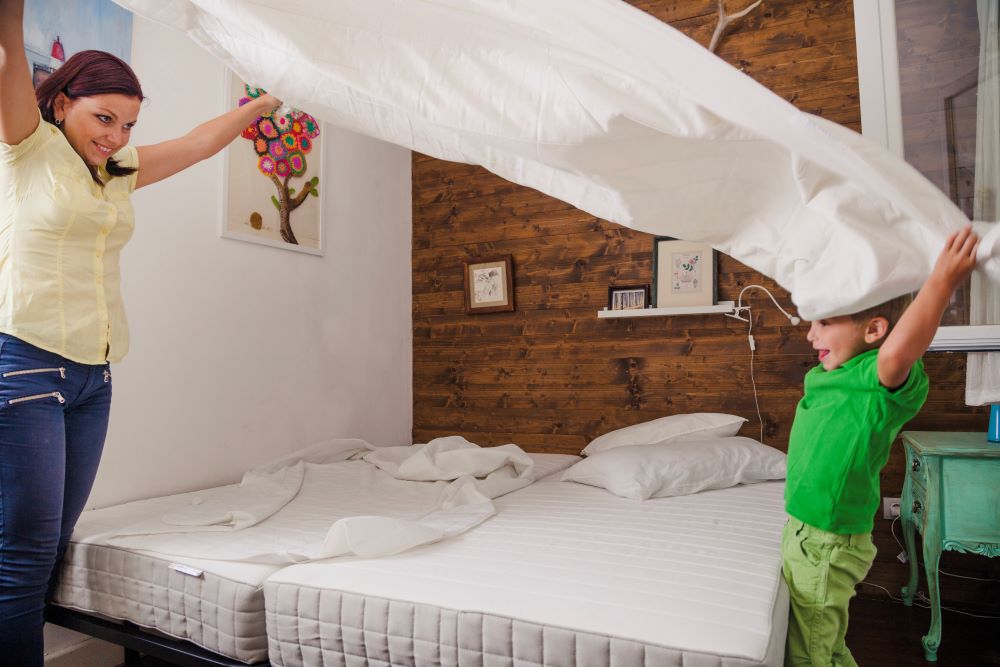
Where Do Bed Bugs Hide in Your Home?
Bed bugs are a persistent and frustrating pest that can wreak havoc in our homes. These tiny, elusive creatures feed on human blood and can quickly infest even the cleanest of living spaces. To successfully remove bed bugs from your home, it is crucial to identify their hiding spots and understand their behavior. By knowing where bed bugs like to lurk, you can take targeted actions to eliminate them and reclaim your living space.
In this comprehensive guide, we will explore the common and advanced hiding spots of bed bugs, providing you with the knowledge and strategies to effectively tackle this pest problem.
Understanding Bed Bug Behavior
Bed bugs are resilient insects that go through a life cycle consisting of egg, nymph, and adult stages. These bugs are adept at moving and spreading, often hitchhiking on clothing, luggage, and furniture to find new homes. Several key factors influence bed bug behavior, including temperature, humidity, and the availability of their primary food source – human blood.
Bed bugs are nocturnal creatures, typically becoming active at night when their human hosts are sleeping. They are skilled at hiding in small cracks and crevices, emerging only to feed and then quickly retreating back to their hiding places. Understanding these behavioral patterns is essential for effectively locating and eliminating bed bugs from your home.
Common Bed Bug Hiding Spots
Mattress and Box Spring
Bed bugs are known to thrive in the seams, tufts, and crevices of mattresses and box springs. These areas provide ample hiding spots and easy access to their human hosts. Thoroughly inspecting and treating these areas is a crucial step in bed bug removal.
Tips for Inspecting and Treating Mattresses and Box Springs:
- Carefully examine the entire surface, including the underside, for any signs of bed bugs, such as live insects, eggs, or fecal matter.
- Pay close attention to the edges, seams, and tufts, as these are common hiding spots.
- Use a flashlight and magnifying glass to aid in your inspection.
- If bed bugs are found, consider replacing the mattress and box spring, or use a high-quality mattress encasement to trap any remaining bugs.
Bed Frame and Headboard
Bed frames and headboards can also harbor bed bugs, as they often have cracks, crevices, and joints that provide ideal hiding places. Bed bugs may also congregate in the spaces between the bed frame and the wall.
Methods for Inspecting and Treating Bed Frames and Headboards:
- Carefully examine the entire bed frame, including the joints, crevices, and any decorative elements.
- Use a screwdriver or other tool to disassemble the bed frame, if possible, to gain better access to potential hiding spots.
- Treat any infested areas with an EPA-registered insecticide or other effective bed bug control method.
- Consider replacing the bed frame or headboard if they are heavily infested and difficult to treat.
Curtains and Drapes
Bed bugs can also hide in the folds, seams, and crevices of curtains and drapes. These textiles provide ample hiding spots and easy access to sleeping hosts.
Techniques for Inspecting and Treating Curtains and Drapes:
- Thoroughly inspect the entire surface of the curtains and drapes, paying close attention to the hems, folds, and seams.
- Consider removing the curtains and drapes for a more thorough inspection and treatment.
- Wash the curtains and drapes in hot water and dry them on the highest heat setting to kill any bed bugs and eggs.
- Vacuum the areas where the curtains and drapes were hanging to remove any remaining bugs or eggs.
Furniture and Carpets
Bed bugs can also make their home in the cracks, crevices, and upholstery of furniture, as well as in the fibers of carpets and rugs.
Methods for Inspecting and Treating Furniture and Carpets:
- Carefully examine all furniture, including couches, chairs, dressers, and nightstands, for any signs of bed bugs.
- Look for cracks, crevices, and areas where the upholstery meets the frame, as these are common hiding spots.
- Vacuum thoroughly, paying special attention to the seams and crevices of furniture and the edges of carpets and rugs.
- Consider professional steam cleaning or treatment of heavily infested furniture and carpets.
Electrical Outlets and Switches
Surprisingly, bed bugs can also hide in the small cracks and crevices around electrical outlets and light switches. These areas provide easy access to their human hosts and a safe haven from detection.
Techniques for Inspecting and Treating Electrical Outlets and Switches:
- Carefully inspect the areas around electrical outlets and light switches, using a flashlight and magnifying glass to search for any signs of bed bugs.
- Avoid removing outlet covers or light switch plates, as this may disturb the bugs and cause them to scatter.
- Treat the surrounding areas with an EPA-registered insecticide or other effective bed bug control method.
Behind Wallpaper and Paint
Bed bugs can also hide behind wallpaper and paint, taking advantage of the small spaces and crevices that these materials provide.
Methods for Inspecting and Treating Areas Behind Wallpaper and Paint:
- Carefully inspect the walls, looking for any signs of bed bugs, such as fecal matter or shed skins.
- If bed bugs are suspected, consider removing sections of the wallpaper or paint to gain better access to the affected areas.
- Treat the exposed areas with an EPA-registered insecticide or other effective bed bug control method.
- Repair any damaged wallpaper or paint to prevent future infestations.
Under Carpets and Rugs
Bed bugs can also hide under carpets and rugs, taking advantage of the small spaces and crevices that these floor coverings provide.
Techniques for Inspecting and Treating Areas Under Carpets and Rugs:
- Carefully inspect the edges and fringes of carpets and rugs, looking for any signs of bed bugs.
- Consider lifting the carpet or rug to inspect the underlying floor and baseboards for any signs of infestation.
- Treat the affected areas with an EPA-registered insecticide or other effective bed bug control method.
- Vacuum the carpet or rug thoroughly to remove any remaining bugs or eggs.
Behind Baseboards and Molding
Bed bugs can also hide behind baseboards and molding, taking advantage of the small cracks and crevices in these areas.
Methods for Inspecting and Treating Areas Behind Baseboards and Molding:
- Carefully inspect the baseboards and molding, looking for any signs of bed bugs, such as fecal matter or shed skins.
- If bed bugs are suspected, consider removing sections of the baseboards or molding to gain better access to the affected areas.
- Treat the exposed areas with an EPA-registered insecticide or other effective bed bug control method.
- Repair any damaged baseboards or molding to prevent future infestations.
Advanced Bed Bug Hiding Spots
While the common hiding spots mentioned above are the most well-known, bed bugs can also find refuge in some more unexpected places.
You may also read (prevent pest tips home)
Behind Wall Decals and Stickers
Bed bugs can hide behind wall decals and stickers, taking advantage of the small spaces and crevices that these decorative elements provide.
Techniques for Inspecting and Treating Areas Behind Wall Decals and Stickers:
- Carefully inspect the areas around wall decals and stickers, looking for any signs of bed bugs.
- Consider removing the decals or stickers to gain better access to the affected areas.
- Treat the exposed areas with an EPA-registered insecticide or other effective bed bug control method.
- Repair or replace the wall decals or stickers to prevent future infestations.
In Bookshelves and Bookcases
Bed bugs can also hide in the cracks and crevices of bookshelves and bookcases, taking advantage of the small spaces and the potential for human hosts to frequent these areas.
Methods for Inspecting and Treating Bookshelves and Bookcases:
- Carefully inspect the entire bookshelf or bookcase, including the shelves, joints, and any decorative elements.
- Remove all books and other items to gain better access to the affected areas.
- Treat the exposed areas with an EPA-registered insecticide or other effective bed bug control method.
- Thoroughly vacuum the area to remove any remaining bugs or eggs.
In Upholstered Furniture
Bed bugs can also hide in the upholstery of furniture, such as couches, chairs, and ottomans, taking advantage of the small spaces and the potential for human hosts to frequent these areas.
Techniques for Inspecting and Treating Upholstered Furniture:
- Carefully inspect the entire surface of the upholstered furniture, including the seams, crevices, and any decorative elements.
- Consider professional steam cleaning or treatment of heavily infested upholstered furniture.
- Vacuum the furniture thoroughly to remove any remaining bugs or eggs.
In Ceiling Tiles and Light Fixtures
Surprisingly, bed bugs can also hide in ceiling tiles and light fixtures, taking advantage of the small spaces and the potential for human hosts to frequent these areas.
Methods for Inspecting and Treating Ceiling Tiles and Light Fixtures:
- Carefully inspect the ceiling tiles and light fixtures, looking for any signs of bed bugs.
- Avoid removing or disturbing the ceiling tiles or light fixtures, as this may cause the bed bugs to scatter.
- Treat the surrounding areas with an EPA-registered insecticide or other effective bed bug control method.
Conclusion
Bed bugs are persistent and elusive pests that can hide in a wide variety of locations throughout your home. By understanding their behavior and the common and advanced hiding spots they favor, you can take targeted actions to effectively remove them and reclaim your living space.
Remember, the key to successful bed bug removal is thorough inspection and targeted treatment. Be diligent in your search for these pests, and don’t hesitate to seek professional help if the infestation proves to be particularly stubborn.
Take the necessary steps to eliminate bed bugs from your home and prevent future infestations. With the knowledge and strategies provided in this guide, you’ll be well on your way to a bed bug-free living environment.
You may also read (cleaning hacks for maintaining a clean home)


